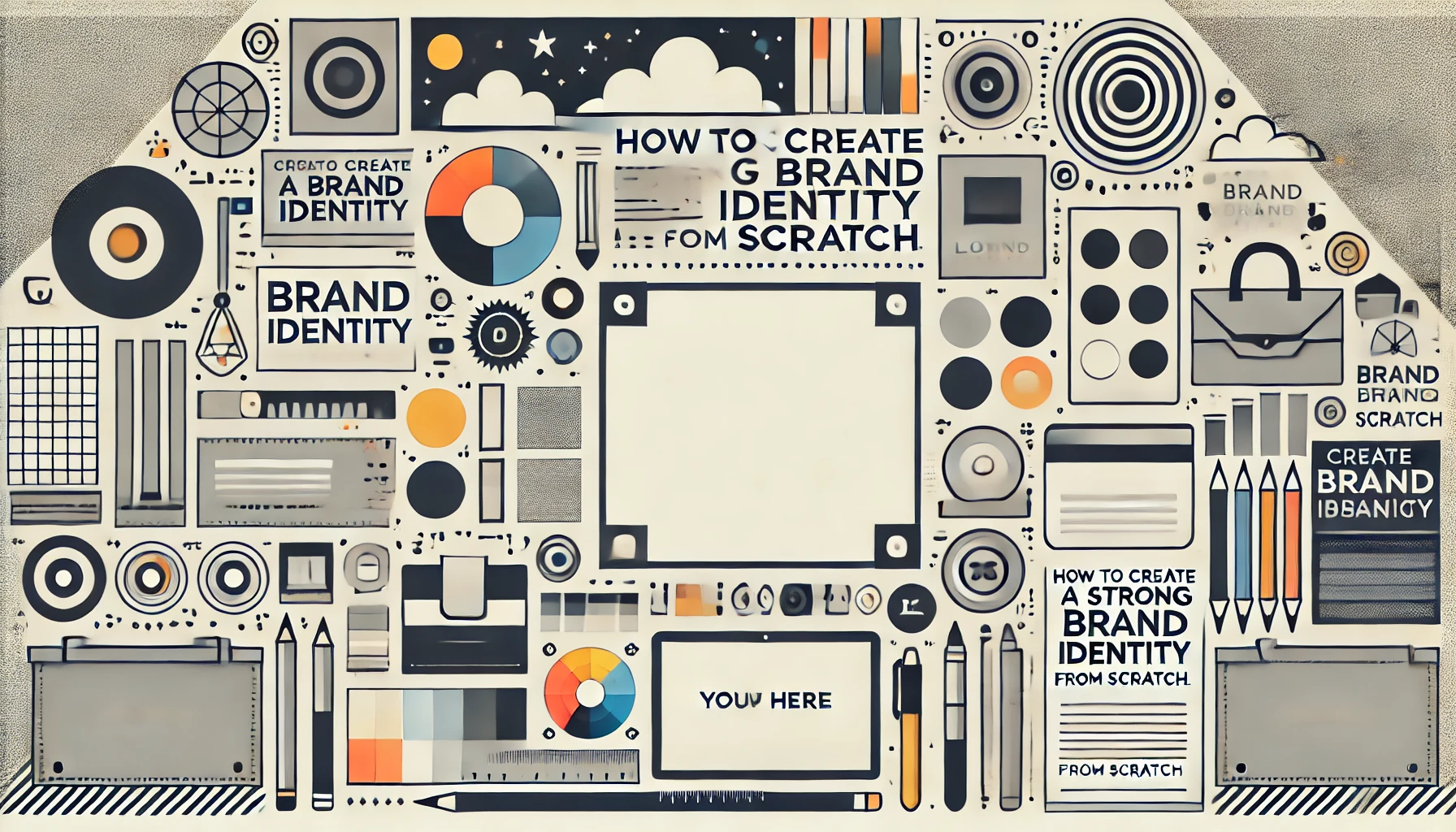Ways to Build a Strong Brand Identity from Scratch
Building a strong brand identity from scratch can seem daunting, but it’s truly an exciting journey. Your brand identity is the perception people have of your business, shaped by your visual elements, communication style, and overall customer experience. Let’s explore effective ways to create a strong brand identity that resonates with your audience.
Understand Your Brand’s Core Mission
Begin by defining what your brand stands for. Ask yourself these questions:
- What problems does my brand solve?
- What values do I want to convey?
- Who is my target audience?
Knowing your core mission will guide all your branding efforts. Make it clear and concise. This mission statement will become a foundational piece of your brand identity.
Create a Unique Visual Identity
Visual elements are crucial in forming your brand identity. This includes your logo, color palette, fonts, and any graphic designs. Aim for originality and consistency. Here’s how:
- Design a Memorable Logo: Your logo should reflect your brand’s personality and make a memorable impression.
- Choose a Color Scheme: Colors evoke emotions. Select colors that align with your brand values.
- Pick Fonts Wisely: The typography you choose further communicates your brand’s tone. Ensure it’s legible and aligns with your identity.
Consistent use of these elements across all platforms helps in establishing recognition and trust.
Craft Your Brand Voice
Your brand’s voice sets the tone for all your communications. Whether it’s casual, formal, playful, or authoritative, your brand voice should be consistent. Think about:
- How will you talk to your customers?
- What language and tone align with your personality?
- How do you want customers to feel when they interact with your brand?
Creating a style guide can help maintain consistency in how your brand communicates across different channels.
Know Your Target Audience
Understanding the people you’re trying to reach is crucial. Conduct market research to gather insights about your audience’s needs, preferences, and behaviors. Some effective methods include:
- Surveys and questionnaires
- Social media insights
- Customer interviews and focus groups
This knowledge will help shape your messaging and ensure your brand identity resonates with the right people.
Deliver Consistent Brand Experiences
Every interaction a customer has with your brand should reinforce your identity. From your website to social media and customer service, consistency is key. Here’s what you can do:
- Website Design: Your website should reflect your brand’s visual identity and be user-friendly.
- Social Media Presence: Ensure your social media platforms align with your branding elements and messaging.
- Customer Service: Train employees to communicate in a way that represents your brand voice.
Each touchpoint should feel cohesive and reinforce how you want to be perceived.
Engage and Gather Feedback
One of the best ways to strengthen your brand identity is to engage with your audience and listen to their feedback. Utilize feedback mechanisms like:
- Social media polls
- Customer reviews and testimonials
- Regular follow-ups and check-ins
Listening to your customers can provide invaluable insights that help refine your identity and improve user experience.
Adapt and Evolve
The market is constantly changing, and so should your brand. Stay aware of industry trends and be ready to adapt. You can:
- Monitor competitor strategies
- Evaluate your brand positioning regularly
- Solicit ongoing customer feedback for continuous improvement
By thriving in a dynamic market, you’ll keep your brand identity relevant and engaging.
Creating a strong brand identity from scratch is about clarity, consistency, and connection. With time and dedication, you’ll build a brand that not only stands out but also resonates with your target audience on a deeper level.
The Importance of Consistency in Branding
In the ever-evolving market, building a strong brand is not just about having a catchy slogan or an eye-catching logo. It’s about creating a consistent experience that resonates with your audience. Consistency in branding is crucial for establishing recognition and trust, two key components that drive customer loyalty and ultimately influence purchasing decisions.
When you think of brands like Coca-Cola or Apple, what comes to mind immediately? The logo, the color scheme, and the emotional connection associated with those brands are consistently presented across all touchpoints. This establishes familiarity and creates a lasting impression. Here’s why maintaining consistency in your branding is imperative:
1. Builds Recognition
When consumers see the same colors, fonts, and messaging repeatedly, it reinforces your brand identity. Familiar elements help people remember your brand easily and distinguish it from competitors. Here are some ways to enhance recognition:
- Color Scheme: Choose specific colors that represent your brand’s personality. Use them consistently across all platforms.
- Logo: Your logo should remain unchanged once established. It symbolizes your brand and helps create an emotional connection.
- Typography: Select a couple of fonts to use consistently in all marketing materials. This creates a unified look.
2. Fosters Trust and Credibility
Consistency leads to trust. When your messaging and visuals are uniform, customers associate these qualities with dependability. An inconsistent brand can confuse consumers and even lead them to question your professionalism. Remember, trust is a cornerstone of customer relationships. Here are a few strategies to build trust:
- Messaging: Make sure that your brand voice and messages are uniform across all channels, whether it be social media, your website, or print materials.
- Customer Experience: Ensure that every interaction your customer has with your brand, both online and offline, delivers the same experience. This means training staff to adhere to brand guidelines.
- Content Quality: Maintain high-quality content across platforms, showcasing your commitment to your product or service.
3. Enhances Professionalism
In a world where consumers have numerous choices, a polished and cohesive brand image can set you apart. A strong brand identity that is consistently presented conveys professionalism. This can be particularly important if you operate in a competitive industry. Here are ways to maintain professionalism:
- Brand Guidelines: Create comprehensive brand guidelines outlining how to use logos, colors, and fonts across platforms. Share these with your team to maintain consistency.
- Visual Content: Use high-quality visuals that align with your brand’s tone and message in all marketing materials.
- Regular Reviews: Conduct regular audits of your brand presence across all channels to ensure consistency.
4. Supports Marketing Efforts
Your marketing campaigns will be more effective with a strong and consistent brand identity. When your audience sees a unified message and design, they are more likely to remember and engage with your campaign. Look at these points for effective marketing:
- Promotion Strategies: Use the same branding elements in all advertising and promotional materials to create a seamless experience.
- Social Media Presence: Your social media profiles should reflect your brand identity. This encourages customer engagement.
- Cross-Channel Marketing: Whether on email, social media, or your website, your branding should feel connected. A cohesive approach strengthens your message.
Building a consistent brand identity is not merely an option but a necessity for success. Whether you’re launching a new venture or rebranding an existing business, keeping your branding consistent eases the journey towards recognition, trust, professionalism, and effective marketing. Paying meticulous attention to the details of your branding can pave the way for stronger customer relationships and ultimately lead to greater success.
By remaining aware of these elements and striving for consistency in your branding efforts, you ensure that your brand will stand strong amidst the ever-changing landscape of modern business.
How Colors and Logos Influence Brand Perception
When it comes to shaping how people see your brand, colors and logos play a vital role. The choices you make about these elements impact the emotions and perceptions of your target audience. Understanding this influence can help you create a powerful and memorable brand identity.
Colors have a unique ability to evoke feelings and associations. For example, blue is often linked to trust and reliability, making it a popular choice for financial institutions and healthcare brands. On the other hand, red can evoke excitement and urgency, which is frequently used in food and entertainment industries. Here are some examples of common colors and their emotional impacts:
- Blue: Trust, security, calmness
- Red: Passion, urgency, excitement
- Green: Growth, health, tranquility
- Yellow: Optimism, happiness, warmth
- Purple: Luxury, creativity, wisdom
- Black: Elegance, sophistication, power
When choosing colors for your brand, think about the message you want to convey. The right palette can help you connect emotionally with your audience. For instance, if you’re launching a wellness brand, greens and soft blues can create a sense of calm and health. Consider how you want your customers to feel when they see your brand—this response will guide your color selection.
Logos serve as the face of your brand. A well-designed logo is not just visually appealing; it also communicates your brand identity and values at a glance. Think of famous logos—like the swoosh of Nike or the golden arches of McDonald’s. These images instantly bring to mind the qualities of the brands they represent, such as speed, strength, and approachability. When designing your logo, keep these factors in mind:
- Simple Design: A clean and straightforward logo is easier to remember.
- Relevance: Ensure your logo reflects your industry or business focus.
- Versatility: Your logo should look good in various sizes and applications.
- Timelessness: Aim for a classic look that won’t quickly go out of style.
Combining colors and logos strategically can communicate your brand’s essence and differentiate you from competitors. Take time to analyze your competition and identify how their color schemes and logos resonate with their audience. This analysis can reveal gaps in the market that your brand can fill, helping you carve out a unique identity.
The psychological impact of colors extends beyond initial impressions. Once established, your brand colors and logo become instantly recognizable. This recognition creates familiarity, which breeds trust. To maintain that trust, consistency is key. Use your chosen colors and logo across all marketing materials—whether on your website, social media, or packaging. This builds a cohesive brand image that customers recognize and associate with positive experiences.
Testing your chosen colors and logo can provide valuable feedback. Consider running surveys or focus groups to see how potential customers react. Ask them what emotions they feel when they see your logo or how the colors resonate with them. Their insights can guide adjustments to ensure your branding aligns with the perception you want to create.
Monitoring your brand’s reception over time is equally important. Brand perception can shift as you grow and evolve. Engage with your audience through surveys, social media polls, and feedback forms. This ongoing dialogue allows you to adapt to changing preferences and maintain a strong connection with your customers.
Ultimately, the colors and logos you choose are powerful tools in cultivating brand perception. By understanding the psychology behind color choices and the significance of logo design, you can effectively shape how people view and feel about your brand. This awareness will not only enhance your brand identity but also build stronger relationships with your customers, leading to lasting loyalty.
Crafting a Memorable Brand Story
Creating a memorable brand story is essential for any business looking to connect with its audience on a deeper level. Your brand story isn’t just a timeline of what your company has done; it’s the heart of your brand, and it gives customers a way to relate to you. Here is how you can craft a compelling narrative that resonates with your audience.
Understand Your Audience
The first step in creating a brand story is knowing who your audience is. Understanding their needs, desires, and pain points allows you to shape a story that speaks directly to them. Consider the following:
- Demographics: Age, gender, income level, and location can inform how you create your narrative.
- Psychographics: This includes values, interests, and lifestyles that influence buying behavior.
- Feedback: Listen to customer feedback and reviews to get insights into what they care about.
Define Your Core Values
Your core values represent the beliefs and principles that guide your business. These values should shine through in your brand story. To define them:
- Reflect on what is most important to you and your business.
- Identify the qualities that differentiate you from competitors.
- Ensure that your values align with those of your target audience.
By clearly articulating your core values, you create authenticity in your brand story, making it easier for consumers to connect with you.
Crafting the Narrative
The narrative itself should have a clear structure. Here’s how to create one:
- Beginning: Introduce the challenge or conflict. This sets the stage for your audience, helping them relate by showing you understand their struggles.
- Middle: Present how you or your brand came into play as a solution, showcasing your journey and the obstacles you faced.
- End: Wrap up with the success story, illustrating how your brand has positively impacted your customers’ lives.
When crafting this narrative, use an emotional appeal—stories that evoke feelings are often more memorable. Utilize elements like humor, sadness, and triumph to engage your audience.
Incorporate Visual Elements
Visuals can significantly enhance the effectiveness of your brand story. Consider integrating the following:
- Logos: Ensure your logo aligns with your narrative and reflects your values.
- Images and Videos: Use multimedia to showcase your story. Visuals can be more impactful than words alone.
- Infographics: These can summarize your story and make it easier for audiences to digest the information.
Visual elements not only attract attention but also contribute to the retention of your brand story.
Consistency Across Platforms
Once your brand story is crafted, it’s crucial to maintain consistency across all platforms. Whether it’s your website, social media, or marketing materials, your story should remain uniform. This helps reinforce your brand identity and ensures that your message is clear.
Also, adjust your story slightly for different channels. While the core message should remain intact, tailoring it for the platform can enhance engagement. For instance, a more relaxed tone might be fitting for Instagram, while a professional aim could resonate better on LinkedIn.
Engage Your Community
Invite your audience to be part of your brand story. Encourage them to share their experiences through user-generated content, reviews, or testimonials. This not only builds community but also strengthens your narrative by showing real-life impacts of your brand.
Engagement helps humanize your brand further, making it relatable and personable.
In crafting a memorable brand story, focus on creating a narrative that resonates with your audience, communicates your core values, and invites participation. By using the strategies laid out, you can create a compelling brand story that not only captivates but also builds lasting relationships with your customers.
Engaging Your Audience: Strategies for Brand Loyalty
Building strong connections with your audience is essential for creating lasting brand loyalty. People are drawn to brands that resonate with their values and beliefs. To keep them engaged, you need effective strategies that foster emotional ties and encourage repeat interactions. Here are some tried-and-true methods to engage your audience and cultivate loyalty.
Know Your Audience
Understanding your audience is the foundation of effective engagement. Begin by identifying who they are, what they like, and how they communicate. Conduct surveys, interviews, and analyze social media interactions to gather insights. When you know your audience well, you can craft messages that speak directly to them.
Create Quality Content
Content is the backbone of any engagement strategy. It should provide real value to your audience, addressing their needs and interests. Here are ways to create compelling content:
- Informative Articles: Share knowledge about industry trends and tips.
- Engaging Videos: Use visual storytelling to convey your message.
- Interactive Posts: Encourage participation through polls and quizzes.
When your content stands out, it captures attention and keeps your audience coming back for more.
Utilize Social Media Effectively
Social media platforms are powerful tools for audience engagement. Post regularly, interact with followers, and respond to comments promptly. Here are some tips for maximizing social media engagement:
- Be Authentic: Show the human side of your brand. Share behind-the-scenes looks and personal stories.
- Use Visuals: Posts with images or videos often get more engagement than text-only updates.
- Run Contests: Organize contests or giveaways to encourage participation and spread brand awareness.
Engaging with your audience on social media builds trust and establishes a community around your brand.
Provide Excellent Customer Support
Exceptional customer service keeps your audience satisfied and loyal. Make support easily accessible through various channels like email, live chat, and social media. Here’s how to enhance customer support:
- Be Responsive: Aim for quick reply times. A timely response shows you value your customers.
- Personalize Interactions: Use their names and personalize responses to their inquiries.
- Ask for Feedback: Encourage customers to share their experiences. Use their input to improve your services.
When customers feel heard and valued, it fosters a strong connection to your brand.
Build a Community
Creating a community around your brand can significantly boost loyalty. Encourage interaction among your audience through forums, social media groups, or community events. Consider these ideas:
- Host Webinars: Share your expertise and invite your audience to ask questions.
- Create Special Interest Groups: Form groups based on shared interests related to your brand.
- Encourage User-Generated Content: Motivate your audience to share photos and experiences with your products.
When customers feel they’re part of something special, their loyalty to your brand grows stronger.
Be Consistent but Adaptable
Consistency in messaging and branding helps reinforce brand identity. However, it’s equally crucial to adapt to changes in market trends and audience preferences. Regularly evaluate your strategies and be open to innovation. Flexibility allows you to stay relevant and maintain audience interest.
Recognize and Reward Loyalty
Always acknowledge the loyalty of your audience. Implement reward programs or exclusive offers for long-time customers. Here are some ways to show appreciation:
- Loyalty Programs: Create a points system where customers earn rewards for purchases.
- Exclusive Access: Offer loyal customers early access to new products or sales.
- Personalized Discounts: Send special promotions based on their buying history.
Acknowledging your audience’s loyalty encourages them to continue supporting your brand.
By implementing these strategies, you’ll create a powerful bond with your audience, turning them into loyal customers. The goal is to stay engaged and provide value while adapting to their changing needs. With time and genuine effort, brand loyalty can flourish.
Conclusion
Creating a strong brand identity from scratch is an exciting journey that lays the foundation for your business’s future success. As we’ve explored, building a solid brand involves various crucial steps. Consistency across all platforms is vital; it helps establish trust and recognition among your audience. The colors and logos you choose play a significant role in shaping how consumers perceive your brand. These visual elements create lasting impressions, making it essential to select designs that resonate with your target audience.
Telling a memorable brand story is another way to connect with your audience on a personal level. This narrative can encapsulate your values and mission while highlighting the unique qualities that set your brand apart. When crafted effectively, your story can evoke emotions, making it easier for customers to remember and relate to your brand.
Engaging your audience and nurturing brand loyalty is equally important. By using strategies such as interactive content, social media engagement, and personalized communication, you can create a community around your brand. This connection fosters a sense of belonging, encouraging customers to become loyal advocates who not only support your brand but also share it with others.
Remember, building a strong brand identity is a journey and not a destination. With dedication and a clear focus on the elements we’ve discussed, you can create a brand that not only stands out but also resonates deeply with your audience. Focus on these key areas, and watch your brand identity flourish, attracting both customers and a sense of community.




